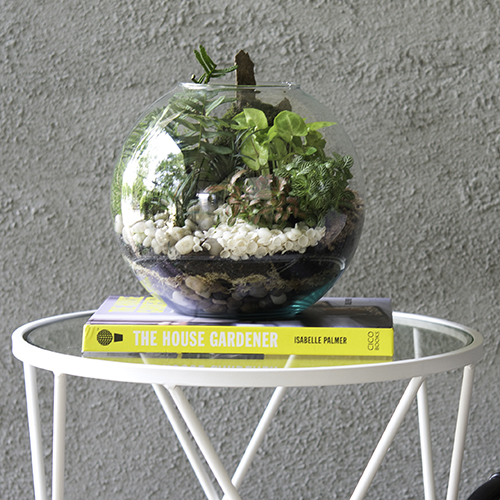Caring for your Living Trends terrarium
Now that you’re the proud owner of a beautiful new fern or succulent terrarium, we’re sure you want to keep it that way. The good news is, terrariums are easy to care for. Here’s everything you need to know to keep your terrarium looking great.
Where to position your terrarium
Because your plants are surrounded by glass, it's important that you don't place them in direct light. The temperature can quickly rise inside your terrarium, essentially roasting your plants.
Your terrarium’s new home should be a spot where it can enjoy plenty of indirect light, like a window that enjoys indirect light for most of the day. Most ferns grow in moist areas under forest canopy, so a fern terrarium will also thrive in low light. As a general rule of thumb, your plant will thrive in a spot where the conditions are similar to those of it's natural environment.
For open terrariums, ensure you keep them away from indoor heaters, air-conditioners and draughts which sap the air of ambient humidity. Closed terrariums don't tend to have this issue as they generate their own humid microclimate.
Watering
Generally speaking, terrariums as a whole need significantly less watering than the average plant due to their lack of drainage. Succulents have adapted to withstand the harshest of conditions, storing water in their thick, fleshy leaves, stems, roots or tubers - which means that by their very nature, succulent terrariums will have very low water needs, and less again if they're closed terrariums. Fern terrariums may need a little more water than their succulent sisters.
Regardless of whether your terrarium is filled with succulents or ferns, when watering, you should only moisten the soil around the root zone and allow the soil to dry out before watering again. It’s always better to underwater if you’re not sure how much water to use – overwatering a terrarium can lead quickly to rot. Using filtered, dechlorinated or distilled water in place of regular tap water will help keep your terrarium balanced and healthy, while preventing mineral deposits and build-up.
Here are some guidelines to watering for both open and closed terrariums.
For open terrariums: Water weekly, or stretch to fortnightly for succulent terrariums. Misting the foliage occasionally will help increase the humidity in a fern terrarium.
For closed terrariums: Water fortnightly at most. The glass should appear clear with some water droplets visible near the top. If the glass turns foggy, you’ve overwatered – leave the lid off for a while to allow the excess to evaporate before replacing it. You should also leave the lid off temporarily if you’re misting your plants. This will allow the foliage to dry, preventing fungal issues and rot.
Feeding
For both succulent and fern terrariums, fertiliser and nutrients should only be given in spring and summer, every two to four weeks at only about a quarter of the recommended dosage. A general liquid or slow-release fertiliser is ideal. Alternatively, try our Living Trends Indoor Plant Food, which is a foliar spray formula. If you go down this route and you have a closed terrarium, just remember to leave the lid off temporarily, allowing the foliage to dry out before replacing it. This will help to prevent rotting.
Cleaning your terrarium
If the glass of your terrarium is looking grimy, you can clean it inside and out, but avoid using harsh cleaning products on the inside if you want to keep your plants happy. We recommend using a solution of equal parts water and white vinegar, which you can use on a paper towel to wipe down all interior and exterior glass areas. If there's a tight spot inside you need to reach, like a corner, try wrapping the moistened paper towel around a long object like a pair of chopsticks to help you get it sparkling clean.
Extra Care Tips
To keep your terrarium looking terrific and to prevent rot, regularly trim to remove any leggy, tatty, brown or damaged foliage, alongside with leaves that have fallen off your plants. Another important part of terrarium maintenance that can be overlooked is cutting back any parts of the plant that are touching the glass. If a plant looks diseased or is on its last legs, remove it carefully, trying not to disturb the roots of other plants and replace with a plant that's similar in size and light needs.
Your terrarium will also love you if you treat it to some fresh air occasionally! For open terrariums, opening the nearest window every so often will do wonders. For closed terrariums, simply remove the lid every two to three weeks – this doubles as the ideal time to lightly trim your plants, if necessary, and perform other maintenance tasks.



